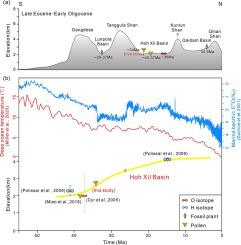Journal of Asian Earth Sciences ( IF 2.7 ) Pub Date : 2021-06-11 , DOI: 10.1016/j.jseaes.2021.104860 Bowen Song , Kexin Zhang , Fang Han , Zhiyuan Liu , Keke Ai , Sha Li , Yadong Xu , Tinglu Yang

|
As the largest intracontinental basin in the Tibetan Plateau hinterland, the Hoh Xil Basin is an ideal area for exploring the coupled history of climate-tectonic relationships in the plateau's interior. However, the detailed paleoenvironmental research on the Hoh Xil Basin is quite insufficient. In this study, we collected palynological and ostracod samples from well-exposed Cenozoic lacustrine strata in the Hoh Xil Basin to reconstruct the paleoenvironment and paleoelevation of the Hoh Xil Basin. Based on the discovery of two key index fossils (Austrocypris cf. posticaudata and Lychnothamnus vectensis), we propose the latest Eocene-early Oligocene (latest Priabonian-earliest Rupelian) age for the strata of the Yaxicuo Formation in the Tongtianhe section. The palynological assemblage suggests that the Hoh Xil Basin was dominated by temperate broadleaved forest and that a warm climate prevailed in this region during the latest Eocene-early Oligocene. Roughly consistent with the overall warm climate confirmed by palynological evidence, the ostracod record indicates that a large freshwater lake existed within the warm environment of the Hoh Xil Basin during the latest Eocene-early Oligocene. By using the coexistence approach (CoA) to evaluate the fossil palynological assemblage, combined with the calibration of the effects of temperature differences and lapse rates, a paleoelevation of 2700 ± 200 m a.s.l. was estimated for the Hoh Xil Basin during the latest Eocene-early Oligocene, representing the height between the basin lake and the crests of the surrounding mountains.
中文翻译:

基于孢粉学和介形虫记录的可可西里盆地(藏中)最新始新世-早渐新世古环境重建
作为青藏高原腹地最大的陆内盆地,可可西里盆地是探索高原内部气候-构造关系耦合历史的理想区域。然而,对可可西里盆地的详细古环境研究还相当不足。在本研究中,我们从可可西里盆地出露良好的新生代湖相地层中采集孢粉学和介形虫样本,以重建可可西里盆地的古环境和古海拔。基于两个关键指标化石(Austrocypris cf. posticaudata和Lychnothamnus vectensis)的发现),我们提出了通天河剖面亚西措组地层的最新始新世-早渐新世(最新的Priabonian-最早的Rupelian)时代。孢粉组合表明可可西里盆地以温带阔叶林为主,在始新世晚期至渐新世早期,该地区气候温暖。与孢粉学证据证实的整体温暖气候大致一致,介形虫记录表明,在最晚始新世-早渐新世期间,可可西里盆地的温暖环境中存在一个大型淡水湖。通过使用共存法(CoA)评估化石孢粉组合,结合温差和递减率影响的校准,古海拔2700±200 m asl











































 京公网安备 11010802027423号
京公网安备 11010802027423号